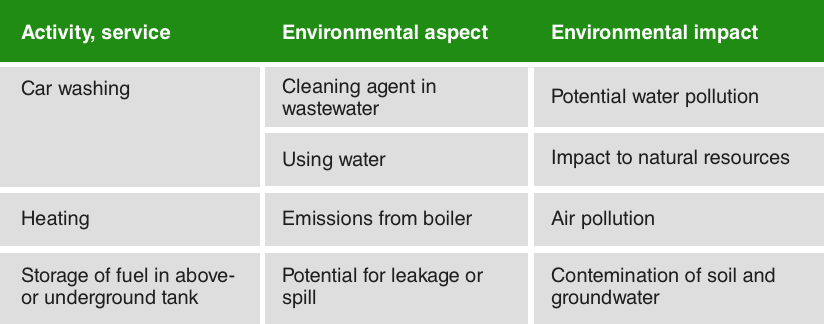Identification and evaluation of significant environmental aspects, especially in the planning phase, is the most fundamental part of ISO 14001. To understand the environmental aspects and impacts is one of the key success factors of implementing an ISO 14001 EMS. In the language of ISO 14001, “an environmental aspect is an element of an organization’s activities, products, or services that has or may have an impact on the environment.”
What exactly is an environmental aspect?
An environmental aspect is the way your activity, service, or product impacts the environment. For example, one of the environmental aspects of car washing may be a cleaning agent that has potential for water pollution (this pollution is the environmental impact).
Below are examples of connections between activities, services, aspects, and impacts.

An environmental impact is a change to the environment. Environmental impacts are caused by environmental aspects.
In the following steps you will find a basic, systematic approach to identifying, evaluating and managing environmental aspects.
1. Definition of the EMS scope
Before you start dealing with environmental aspects and impacts, you should first define the scope of the EMS. You can choose to apply ISO 14001 to the entire organization, or only to a specific unit, location, or product. Once you have made this decision you have defined the EMS scope. Henceforth, all activities, services, and products that fall within your defined scope have to be taken into consideration when you identify environmental aspects and impacts.
2. Identification of environmental aspects
First, let’s explain the terms activity, service, and product. An activity is a part of the core business (e.g., production process steps). Service means an auxiliary service that supports core activities (e.g., boilers, heating & cooling, maintenance). A product is the goods you offer for market. An environmental aspect of the product could be, e.g., excessive packaging of the product, or level of recyclability of the product at the end of its lifecycle.
As ISO 14001 states, “The organization shall establish a procedure to identify environmental aspects and determine those aspects that have or can have a significant impact to the environment.” You should also keep a register of the environmental aspects, which is kept up to date and takes into account planned new or modified activities, products, or services.
Aspects can be divided into direct and indirect. Direct environmental aspects are associated with activities, products, and services of the organization itself, over which it has direct management control (e.g., how you manage waste on your site). However, for non-industrial organizations the focus will often be on indirect environmental aspects of their activities (e.g., how your subcontractor manages waste on your site, chain controlled aspects, customer controlled aspects).
In order to identify your environmental aspects you need to study how your organization’s activities, products, and services affect the environment. The identification of environmental aspects often considers, e.g., emissions to air, releases to water and land, use of raw material, waste and natural resources, impacts on biodiversity, etc.
When identifying environmental aspects, all parts of the company’s operations in the defined scope have to be considered, not just the obvious core manufacturing or service activities. For example, most facilities have a maintenance department, offices, a canteen, heating and cooling systems, vehicle parking, and contractor and supplier activities – each of which may have an impact on the environment.
Various techniques can be used to compile a comprehensive listing of environmental aspects and impacts at a facility – e.g., Value chain method, Process flow method, materials identification, method of compliance with legal requirements, etc.
Good practice is to involve a cross-functional team from key areas of the operation.
For each type of activity, product, or service, you need to list your unique environmental aspect – this will result in an overall list or matrix of aspects and impacts.
3. Evaluation of significant environmental aspects
The purpose of the evaluation of environmental aspects is focusing on what matters the most (e.g., 20-80 rule). You do not need to manage all environmental aspects – only the ones that are, according to your own criteria, declared significant.
Significant environmental aspects are the main focus of your organization’s environmental management system.
Depending on type, nature, and complexity of an organization, there are many techniques available for conducting an evaluation to determine the significance of environmental aspects. In assessing the significance you should consider:
- potential to cause environmental harm
- size and frequency of the aspect
- importance to the stakeholders of the organization
- requirements of relevant environmental legislation
Each organization must establish its own criteria for significance based on a systematic review of its environmental aspects and their actual and potential impacts.
4. Managing significant environmental aspects
Every significant aspect should be brought under control by establishing one or more of the following controls: responsible person (ISO 14001; 4.4.1), training plan (ISO 14001; 4.4.2), or procedure, checklist and/or maintenance schedule (ISO 14001; 4.4.6). Level of control should be appropriate to the nature and risk of the significant aspect. Each of the above is a part of the everyday work routine.
An EMS can often be more complicated than needed. The key to any effective EMS is getting the environmental aspects right at the very beginning. Identifying the environmental aspects properly will not only save you time, but also enable you to achieve great benefits with your EMS once it is implemented.
To learn more about the requirements for environmental aspects, read this free white paper: Clause-by-clause explanation of ISO 14001:2015.


 Robert Verbanac
Robert Verbanac 




